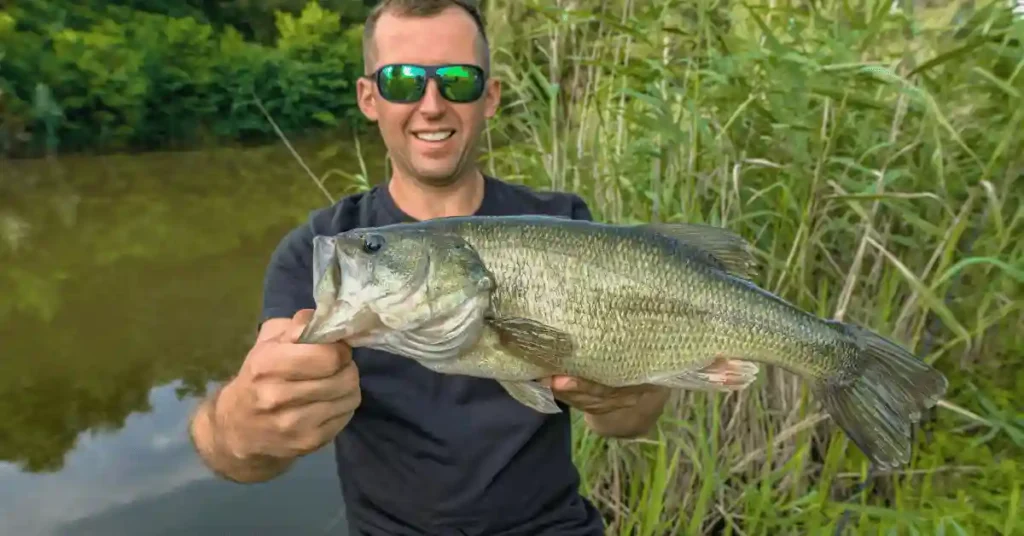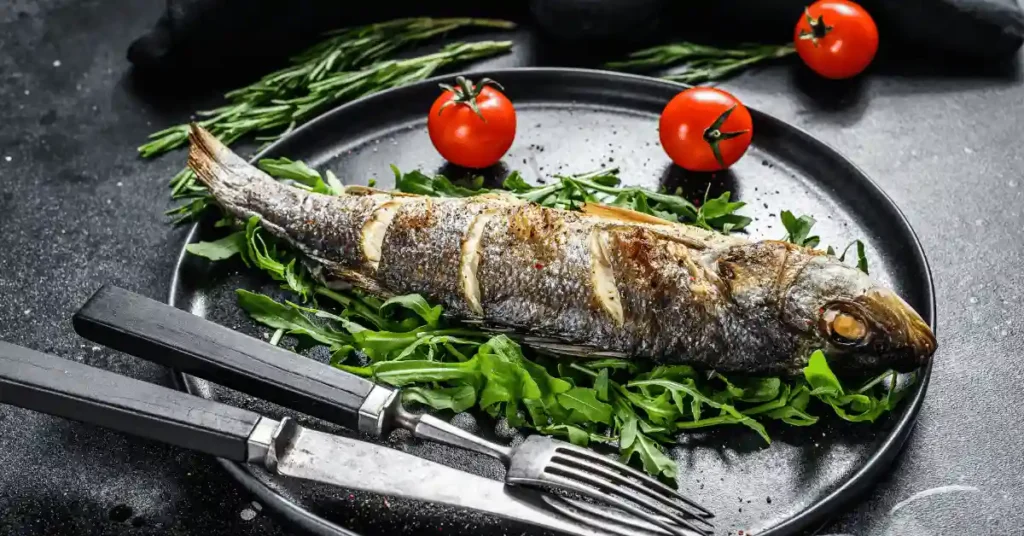Can You Eat Bass? The Biggest Myth In Fishing

If you’ve spent time with pro freshwater bass anglers, you know that eating bass is often considered a major no-no. For some, it’s almost as sensitive a topic as challenging their religious beliefs.
But, as a fishing fan, people often ask me, “Can you eat bass?” It’s worth thinking about because not many talk about eating this favorite game fish. Through my own experiences, I’ve found lots of tasty ways to cook bass.
In this article, I’ll talk about if you can eat bass, the kinds of bass, what they taste like, and why eating more of this fish is a good plan.
Can You Eat Freshwater Bass?
Absolutely! you can eat freshwater bass. Both largemouth and smallmouth bass which are part of the sunfish family, are the most common types of black bass in America, .
This family includes other popular food fish like crappie and bluegill. So, if crappie and bluegill are delicious, then bass should be too!

Despite what some may think, freshwater bass are completely safe to eat. They don’t have more parasites or toxins than any other predatory gamefish.
When cooked properly, bass don’t pose any health risks to humans. In fact, they’re just as healthy and safe to eat as any other freshwater fish.
While it’s true that predatory fish like bass can accumulate mercury, this isn’t unique to bass alone.
To know which fish are safe to eat considering mercury levels, you can check fish consumption guidelines provided by your local state authority.
Generally, larger and older fish tend to have more mercury than smaller ones. So, it’s a good idea to choose smaller bass when picking fish to eat.
Are Freshwater Bass Good To Eat?
The taste and quality of freshwater bass can vary based on a few things like the type of bass, where it lives, and how it’s cooked.
Largemouth and smallmouth bass are similar in flavor, but smallmouth bass are often thought to have a milder taste.

Where the bass lives also matters for its taste. Bass from clean, cold water usually taste better.
But if they’re from dirty or algae-covered ponds, they might not taste as good. Bass, like other fish, can adjust to different environments, which can change how they taste and feel.
There are lots of yummy ways to cook bass, like baking, frying, or grilling. The trick is to use spices and flavors that go well with the fish’s natural taste.
Things like
- lemon
- garlic
- black pepper
- butter can make bass even tastier.
What Freshwater Bass Tastes Like
Freshwater bass come in different types, and each has its own taste, even though they’re all good for eating.
Largemouth Bass
This fish is a popular choice for sport fishing. It has a slightly stronger, fishier flavor compared to other bass.
Bigger ones tend to taste fishier, so smaller ones are usually preferred for cooking. The flesh is firm, white, and mostly bone-free.
Smallmouth Bass
This cousin of the largemouth is also great for eating. Its flesh isn’t as fishy as largemouth bass and is sometimes described as bland.
This makes it a good choice for those who don’t like strong fish flavors.
Smallmouth bass have a sweeter taste than largemouth bass.
Spotted Bass
Another member of the bass family, spotted bass are often mistaken for largemouth or smallmouth bass.
They’re considered by many to be the best-tasting bass. Their flesh is firm, white, and flaky.
Yellow Bass
While not as popular for fishing, yellow bass are commonly eaten.
They have a distinct fishy taste, which some people love and others don’t. Marinating them can help reduce the fishiness.
White Bass
These can have a strong fishy taste that varies depending on how they’re prepared.
They have more oil than other bass, giving the flesh a buttery texture.
The red meat along the ribs is often discarded as it’s the fishiest part, while the white flesh is milder.
Freshwater Bass vs Saltwater Bass
There are some differences between freshwater bass and saltwater bass when it comes to taste and quality.
Freshwater bass, like largemouth and smallmouth bass, usually have a stronger flavor compared to saltwater bass.
The taste of freshwater bass can change depending on where they live, while saltwater bass, such as black sea bass and striped bass, tend to have a milder, sweeter flavor.
Freshwater bass, because of what they eat and where they live, can sometimes taste stronger or more fishy.
Some people might not like this as much. But with the right cleaning and cooking, you can bring out the best flavors in freshwater bass and make a delicious meal.
Saltwater bass, like black sea bass and striped bass, have firm and tender meat. They have a mild, sweet flavor that a lot of people love.
You can cook them in lots of different ways, like baking, frying, or grilling. And when you add seasonings like onion, garlic, or lemon, you can make some really tasty dishes with saltwater bass.
Why Eating More Bass is a Good Idea
There are a bunch of reasons why adding bass to your diet can be a good move. First off, bass is a great source of lean protein that’s low in bad fats and high in important stuff like omega-3s, vitamin D, and B vitamins.
Having bass in your meals can help make sure you’re getting all the good stuff your body needs.

Plus, catching and eating smaller bass from ponds and lakes can actually help manage the fish population and make room for bigger ones.
By taking out some of the little guys, you give the rest more space and food to grow, which means they can get bigger faster. This helps keep the ecosystem healthy and balanced.
Eating bass can also be a smart choice for the environment.
Instead of relying only on big commercial fishing operations for your seafood, eating locally caught bass can ease the pressure on ocean resources and support your local economy.
Just make sure you fish responsibly and follow the rules to make sure there are enough bass for the long haul.
Why Do People Avoid Eating Bass?
Even though bass is edible and can be really tasty, a lot of folks still don’t eat it. There are a few reasons for this.
One big reason is the catch-and-release culture. Bass, especially largemouth bass, are super popular for sport fishing because they fight hard when caught.
Anglers have moved away from using bass as food and instead enjoy catching and releasing them. This has made people think bass aren’t meant to be eaten.
Another reason might be all the myths and rumors about how bass tastes. Some think it tastes muddy or has worms, while others just prefer other kinds of fish.
But a lot of these ideas are based on what people have heard rather than what they’ve actually tasted.
Trying bass yourself can show you it’s not as bad as you might think and might even lead to some tasty new dishes.
You Should Also Read: Why Shouldn’t you Eat Bass.
Catch and Release Bass
Catch and release has become super popular among anglers, and it’s a good thing for keeping fish populations healthy for the future. But, it’s not always the right move for bass fishing.
In smaller ponds and lakes, where there aren’t a lot of bass and they might be struggling to find enough food or space, it can actually help to catch and keep some of the smaller bass.
Taking out the smaller ones gives the rest more room and food, so they can grow bigger and faster.
Wildlife experts often suggest taking out a certain number of bass per acre each year in these places to keep the population healthy.
But in bigger lakes that get a lot of fishing and don’t have as much food for each acre, catch and release is usually the way to go.
This helps make sure the bass have a chance to survive and keep growing.
It’s super important to follow the rules and guidelines for fishing in your area to make sure you’re doing it responsibly.
Biomass: Why It’s a Big Deal
When we’re talking about managing fish populations, biomass is super important. Biomass means the total weight of all the fish in a body of water.
How much food is around decides how much biomass there is, and each lake or river has its own limit on how much fish it can handle.
When we’re talking about managing fish populations, biomass is super important. Biomass means the total weight of all the fish in a body of water.
How much food is around decides how much biomass there is, and each lake or river has its own limit on how much fish it can handle.
For bass, what matters is the total biomass, not how many individual fish there are.
For instance, ten bass weighing 5 pounds each have the same biomass as fifty bass weighing 1 pound each. The goal is to keep a steady and balanced population that can grow and reproduce without problems.
Taking out smaller bass can help control the biomass and make things better for the rest of the fish.
By getting rid of the smaller ones, you make sure there’s enough food for the bigger bass to get bigger and have babies.
This helps keep the fish population healthy and might even lead to bigger trophy-sized bass down the line.
Which Bass Are Best To Eat?
When it comes to picking bass for eating, there are a few things to think about. Size matters because it affects how the fish tastes and feels.
Bigger bass usually have softer meat and a stronger flavor, while smaller ones are softer and milder. The best size for eating bass is usually between 12 and 15 inches. They have enough meat for a good meal but still taste great.
Another thing to think about is where the bass lives. Bass from clean, cool water with fewer weeds usually taste better. The quality of the water and what the bass eat can change how they taste.
Lastly, it’s important to clean and handle the bass properly when getting it ready to eat.
Cleaning it well and taking out any dark bits can make the fillets taste better and look nicer. You can find guides or videos online to help you learn how to fillet bass step by step.
Cooking Bass: Important Tips
When you’re cooking bass, there are a few things to remember to get the best results.
First off, freshness is key. Make sure to ice your bass right away and avoid letting them sit in a live well or cooler for too long. Handling and storing the fish properly will help keep it tasting its best.
It’s also a good idea to take out the lateral line and any dark bits from the fillets before cooking.
This can make the dish taste better and look nicer. You can find reliable guides or videos online to learn how to clean and prepare bass fillets step by step.
Lastly, remember that frozen bass might not taste as good as fresh bass.
Freezing can change the flavor and texture of the fish. If you can, try to enjoy bass as soon as you catch it for the best taste.
Final Thought on Eating Bass
In closing, the idea that bass isn’t good for eating is simply not true. Freshwater bass, like largemouth, smallmouth, black sea, and striped bass, can be not just safe but downright tasty when cooked right.
How good they taste can depend on things like the kind of bass it is, where it lives, and how it’s prepared.
While catch and release is common and helps keep fish numbers up, sometimes taking out smaller bass from certain places can actually be good for the whole ecosystem.
Just make sure to follow the rules where you’re fishing.
If you get the chance, give bass a try. Whether it’s a juicy largemouth fillet or a delicate black sea bass dish, you might find a new favorite seafood.
With the right cleaning and cooking, bass can turn into a delicious meal packed with good stuff.
So, next time you’re out fishing, think about keeping a bass or two for dinner. Explore the tasty possibilities of these freshwater gems and savor the flavors of the water.

Meet Ibrahim Khan, an avid angler and author in Fishing Teach. He shares his wealth of knowledge from his 16 years of experiences in fishing. His articles are a captivating blend of practical insights and thrilling tales that invite readers into the enchanting world of fishing.
Ibrahim’s guides are your go-to guide in the realm of fishing on this informational site. Hailing from a coastal paradise, Ibrahim’s passion for angling is the heartbeat of his life.
